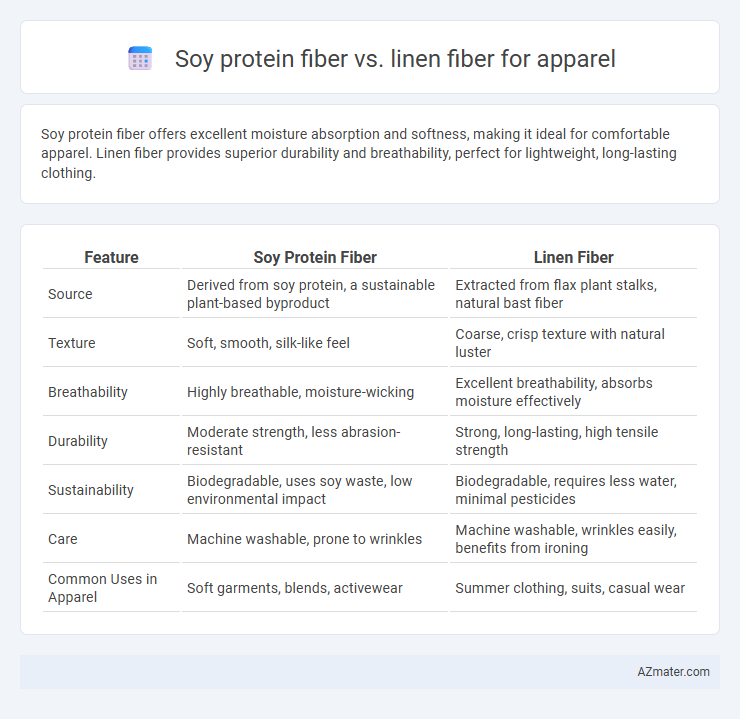Soy protein fiber offers excellent moisture absorption and softness, making it ideal for comfortable apparel. Linen fiber provides superior durability and breathability, perfect for lightweight, long-lasting clothing.
Table of Comparison
| Feature | Soy Protein Fiber | Linen Fiber |
|---|---|---|
| Source | Derived from soy protein, a sustainable plant-based byproduct | Extracted from flax plant stalks, natural bast fiber |
| Texture | Soft, smooth, silk-like feel | Coarse, crisp texture with natural luster |
| Breathability | Highly breathable, moisture-wicking | Excellent breathability, absorbs moisture effectively |
| Durability | Moderate strength, less abrasion-resistant | Strong, long-lasting, high tensile strength |
| Sustainability | Biodegradable, uses soy waste, low environmental impact | Biodegradable, requires less water, minimal pesticides |
| Care | Machine washable, prone to wrinkles | Machine washable, wrinkles easily, benefits from ironing |
| Common Uses in Apparel | Soft garments, blends, activewear | Summer clothing, suits, casual wear |
Introduction to Soy Protein Fiber and Linen Fiber
Soy protein fiber, derived from soybeans, is a sustainable textile known for its softness, moisture absorption, and biodegradability, making it ideal for eco-friendly apparel. Linen fiber, extracted from the flax plant, offers exceptional durability, breathability, and natural luster, favored in warm-weather clothing for its cooling properties. Both fibers are renewable and biodegradable, with soy protein providing a silk-like feel, while linen excels in strength and moisture-wicking performance.
Historical Development of Both Fibers
Soy protein fiber emerged in the late 20th century as an innovative, sustainable alternative to traditional textile fibers, utilizing byproducts from soybean processing to create soft, biodegradable fabric. Linen fiber, derived from the flax plant, boasts a rich history dating back thousands of years, prominently used by ancient civilizations for its durability and breathability. The historical development of these fibers highlights a transition from ancient, natural flax cultivation to modern biotechnological advancements in soy protein fiber production, reflecting evolving textile industry priorities.
Fiber Source and Sustainability
Soy protein fiber, derived from soybeans, offers a sustainable alternative to traditional fibers by utilizing agricultural byproducts and reducing waste, while linen fiber comes from the flax plant, known for its low water and pesticide requirements. Soy protein fibers provide softness and biodegradability, promoting eco-friendly fashion with a focus on circular economy principles. Linen's durability and minimal environmental impact make it a preferred choice for sustainable apparel that emphasizes renewable plant-based resources.
Physical Properties Comparison
Soy protein fiber exhibits a soft texture, high moisture absorption, and excellent elasticity, making it suitable for comfortable, breathable apparel. Linen fiber is known for its exceptional strength, durability, and natural luster, with superior moisture-wicking abilities and a crisp texture that softens over time. The physical durability of linen contrasts with soy protein fiber's smooth, pliable nature, offering distinct advantages depending on the desired apparel characteristics.
Comfort and Wearability in Apparel
Soy protein fiber offers exceptional softness and moisture-wicking properties, enhancing comfort and breathability in apparel. Linen fiber provides superior durability and a natural cooling effect, making it ideal for warm-weather wear with excellent breathability. Both fibers contribute to wearability, with soy protein fiber excelling in softness and stretchability, while linen stands out for strength and long-lasting freshness.
Moisture Absorption and Breathability
Soy protein fiber offers excellent moisture absorption due to its hydrophilic properties, making it highly effective in wicking sweat away from the skin. Linen fiber, derived from flax, provides superior breathability as its natural hollow structure allows air circulation, keeping the wearer cool and comfortable. Combining soy protein fiber with linen can enhance both moisture management and ventilation in apparel.
Durability and Longevity
Soy protein fiber offers moderate durability with a silky texture, but it tends to be less resilient under stress compared to linen fiber, which boasts exceptional strength and longevity due to its natural flax origins. Linen fibers maintain structural integrity over time, resisting pilling and wear, making them ideal for apparel requiring extended lifespan and frequent use. Although soy protein fiber provides softness and comfort, linen fiber is superior for durable clothing that withstands long-term wear and multiple wash cycles.
Dye Affinity and Color Retention
Soy protein fiber exhibits excellent dye affinity due to its protein-based structure, allowing vibrant and rich color absorption, which enhances the apparel's aesthetic appeal. Its superior color retention properties withstand multiple washes and UV exposure without significant fading, making it ideal for long-lasting vivid garments. In contrast, linen fiber, derived from flax, tends to have moderate dye affinity, often resulting in more muted tones, and may experience quicker color fading due to its cellulose composition and porous surface.
Environmental Impact and Biodegradability
Soy protein fiber, derived from byproducts of soybean processing, offers a biodegradable and renewable alternative with a lower carbon footprint compared to synthetic fibers, utilizing agricultural waste to reduce resource consumption. Linen fiber, sourced from flax plants, is highly sustainable due to its minimal water and pesticide requirements, and its natural biodegradability enriches soil when decomposed. Both fibers demonstrate strong environmental benefits, but linen's cultivation efficiency and soil health contributions provide a superior ecological advantage in sustainable apparel production.
Market Trends and Future Outlook
Soy protein fiber is gaining momentum in the sustainable apparel market due to its biodegradability, softness, and moisture-wicking properties, aligning with increasing consumer demand for eco-friendly and plant-based textiles. Linen fiber remains a staple in the industry, prized for its durability, breathability, and natural luster, with a steady demand supported by its environmental benefits and versatility in fashion. The future outlook suggests a growing hybridization of these fibers, targeting enhanced performance and sustainability to meet evolving market trends focused on reducing environmental impact and promoting circular fashion.

Infographic: Soy protein fiber vs Linen fiber for Apparel
 azmater.com
azmater.com